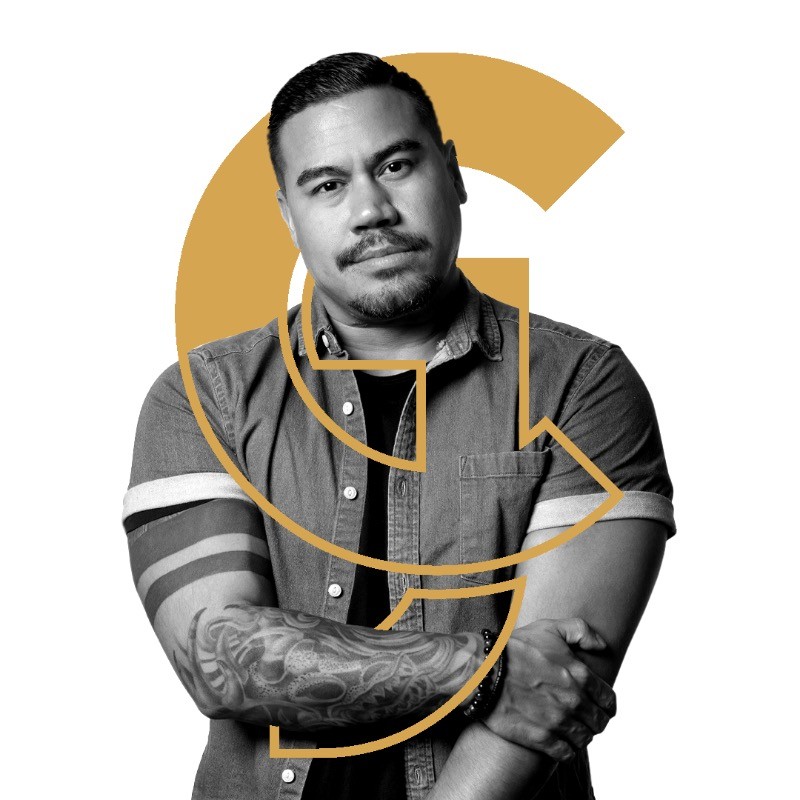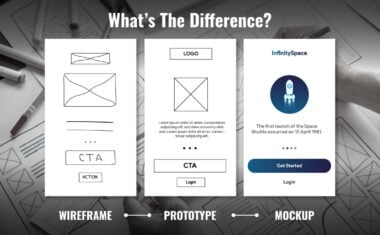Free UX Design Course
Dive into UX design with our free starter course. Transform your creative ideas into user-friendly solutions.
In this detailed guide, we’ll explore the vibrant UI industry as it stands in 2024, discuss why now is the perfect time to start your career and provide you with all the tools and knowledge you need to make a successful transition.
Whether you’re a beginner or looking to shift careers, our insights will help you navigate this creative and ever-evolving field. Join us as we delve into the essentials of becoming a UI designer and turn your passion for design into a thriving career.
Table of Contents
How To Become a UI Designer
Want to become a UI/UX designer but don’t know where to start? Let’s break down the process step by step.
1. Define your goals
Making a list of your career interests helps you clarify what aspects of UI design appeal to you the most. Think about your passions and transferable skills. Are you interested in graphic design? Are you obsessed with typography and color theory? If you have an eye for design, you might be interested in a career as a visual designer. On the other hand, if you’re curious about human-computer interaction and find yourself thinking about ways to make digital products easier to use, you might be interested in interaction design. UI/UX skills will open up a variety of career paths within the design industry.
2. Build your foundational skills
To start your journey in UI design, familiarize yourself with design principles through beginner courses and books. Dive into topics like color theory, typography, and layout, and practice with exercises such as wireframing. Understanding these fundamentals provides a solid foundation for your design skills. Additionally, learning about user interaction and information architecture and conducting user research will help you create intuitive interfaces tailored to user needs and preferences.
UI designers need to collaborate effectively with cross-functional teams, including UX designers, developers, and project managers. Develop strong communication and interpersonal skills to effectively convey your design ideas and work well within a team. Additionally, cultivate skills such as problem-solving and time.
3. Reinforce your skills with free resources
Use free design tutorials to sharpen your technical skills and brush up on basic principles of design. Experiment with free resources like:
- Hackdesign. This free resource offers lessons focused on specific areas of UI/UX design, including typography, mobile app analytics, content strategy for interfaces, designing with code, and more. Hackdesign’s lessons are created by top designers involved with companies like Airbnb, Tech Crunch, and more. Design challenges, tool guides, and more are included.
- Figma. Figma offers a collection of design exercises and practice files. Use this free resource to brush up on developing user storyboards, reducing complexity, creating design briefs and mood boards, and more. Figma’s content covers design thinking, accessibility, user research, and other key components of effective UI/UX design.
- UX Project Checklist. From icon usability to micro-interactions, this Github resource covers every component of a successful design project. Use this checklist to evaluate your projects and see where you can make improvements. If you’re stuck or want to learn more about different project components, the checklist offers deep-dive articles on each item.
4. Learn the UI tools
Mastery of design tools is essential in the UI designer’s toolkit. Begin by familiarizing yourself with industry-standard software like Adobe XD, Sketch, or Figma. Many of these tools offer tutorials and resources to facilitate your learning process. Additionally, leverage online communities and video tutorials to grasp the ins and outs of these tools. Practice creating basic UI elements within these platforms to gain hands-on experience and confidence in your skills.
- Adobe XD: A powerful vector-based design tool that allows designers to create interactive prototypes and wireframes for web and mobile applications. It offers features for designing, prototyping, and sharing designs in one platform.
- Sketch: A popular design tool specifically tailored for creating user interfaces for web and mobile applications. It is known for its intuitive interface, extensive library of plugins, and robust vector editing capabilities.
- Figma: A collaborative design tool that enables teams to work together in real-time on UI design projects. It offers features for designing, prototyping, and sharing designs, making it versatile for both individual designers and teams.
- InVision Studio: An all-in-one design tool that allows designers to create high-fidelity prototypes, animations, and micro-interactions. InVision Studio integrates seamlessly with other InVision products for prototyping, collaboration, and user testing.
- Axure RP: A powerful prototyping tool that enables designers to create complex interactive prototypes with dynamic content, conditional logic, and data-driven interactions. It is widely used for prototyping enterprise-level applications and websites.
- Adobe Photoshop: While primarily known as a photo editing tool, Adobe Photoshop is also used by UI designers for creating high-fidelity mockups and visual designs. It offers advanced image editing features and extensive customization options.
5. Take a course
Opting for a UI design course like Springboard’s UX design bootcamp offers aspiring designers a structured path to acquiring essential skills and knowledge in the field. Led by experienced instructors, these courses provide expert guidance and mentorship, coupled with hands-on projects and assignments that allow learners to apply their newfound skills in practical settings. With access to industry-standard tools and resources, participants benefit from a collaborative learning environment, fostering peer interaction and networking opportunities. Moreover, UI design courses often include career support services, equipping learners with the necessary tools and connections to kickstart their careers in UI design.
6. Work on UI projects that align with your interests
Designing projects that dovetails with your passion and unique domain knowledge can help you land a job in that sector. So, if you’re a foodie, then create an app that helps users find new pop-up restaurants in your city. Apply this approach to the types of projects you tackle as well. For example –
- Food discovery app: If you’re passionate about food and dining experiences, consider designing a mobile app that helps users discover new and exciting pop-up restaurants in their city. Focus on creating a user-friendly interface with features such as personalized recommendations, location-based search, and user reviews to enhance the dining experience for food enthusiasts.
- UI design interface: For those interested in UI design, concentrate on creating mockups with visually stunning interfaces that demonstrate your design skills and aesthetic sensibilities. Focus on maintaining consistency and simplicity, prioritize accessibility, utilize prototyping and testing for iterative refinement, and stay updated on the latest trends and best practices. By incorporating the key principles and practices into your design process, you can create UIs that not only look visually stunning but also provide a seamless and delightful user experience.
- User research project: If your interest lies in user research, delve into conducting basic user interviews and analyzing user behavior to create a mock user persona. Develop a project that demonstrates your proficiency in understanding user needs, motivations, and pain points, and use this insight to inform your design decisions effectively.
7. Get feedback on your designs
Feedback is a catalyst for growth in the world of design. Actively seek feedback on your work from peers, mentors, or online communities. Share your designs at various stages, from sketches to prototypes, to gather diverse perspectives and insights. Embrace constructive criticism as an opportunity to refine your skills and iterate on your designs. Similarly, offer feedback to others, as critiquing their work sharpens your own critical eye and communication skills.
Join a design community to ask questions about and get feedback on your design projects. You’ll also be able to use these forums to network. You might even build relationships with designers who could connect you with a future employer. Vibrant design communities include:
- UX Stack Exchange. This question-and-answer forum caters to UI/UX designers, UX researchers, information architects, and interaction designers. From usability to interaction design, each post on the forum is tagged by subject matter, which makes information retrieval a breeze.
- Designer Hangout. This invitation-only network is recommended by industry experts like Jared Spool and Laura Klein. As part of Designer Hangout, you’ll get feedback on your designs as well as opportunities to progress your career through networking.
- Dribbble. Dribble is a community of designers sharing their work. Other users can leave suggestions or praise for your design through comments on the platform.
8. Get real-world experience
Practical experience goes a long way in the eyes of potential employers. To demonstrate your technical skills, you’ll need to bring your designs to life with real projects and collect these projects into a UX design portfolio that you can show to hiring managers. Try redesigning your favorite websites to improve usability, consistency, or user control. Get a design internship, or offer your services as a designer to friends, family, and local businesses free of charge.
- Personal projects: Undertake personal design projects, such as redesigning an existing app or website, creating a portfolio website, or designing UI mockups for fictional products. These projects allow you to practice your skills, experiment with different design techniques, and build a portfolio of work.
- Internships: Seek internships or entry-level positions at design agencies, tech companies, or startups to gain hands-on experience in UI design. Internships offer opportunities to work alongside experienced designers, learn from their expertise, and contribute to real projects while receiving mentorship and guidance.
- Freelance work: Take on freelance design projects for clients or collaborate with small businesses or startups in need of UI design services. Freelancing provides real-world experience working with clients, understanding their requirements, and delivering design solutions tailored to their needs.
- Online platforms: Participate in design challenges and competitions on platforms like Behance, Dribbble, or 99designs to showcase your skills, receive feedback from the design community, and gain exposure. These platforms provide valuable networking opportunities and potential avenues for freelance or full-time work.
9. Network and collaborate
Networking is crucial for aspiring UI designers to build connections, learn from others, and discover opportunities in the field. Here are several ways you can network effectively:
- Online communities: Join online design communities and forums such as Designer Hangout, UX Mastery Community, or Reddit’s r/UI_Design to connect with other designers, share insights, and seek advice. Actively participate in discussions, ask questions, and contribute valuable insights to establish yourself within the community.
- Social media: Utilize platforms like LinkedIn, Twitter, and Instagram to showcase your work, engage with other designers, and connect with industry professionals. Follow design influencers, join relevant groups and hashtags, and share your design projects, thoughts, and experiences to expand your network and visibility.
- Design events and conferences: Attend design events, conferences, and meetups both online and offline to meet fellow designers, industry professionals, and potential employers. Participate in workshops, panel discussions, and networking sessions to exchange ideas, gain inspiration, and forge meaningful connections.
10. Seek mentorship
Mentorship can accelerate your growth as a UI designer by providing personalized guidance and support. Reach out to experienced designers in your network or online communities and express your interest in mentorship. Be respectful of their time and demonstrate your eagerness to learn and improve. Alternatively, explore mentorship programs offered by design organizations or companies, which pair mentees with experienced mentors for guidance and advice.
11. Build a portfolio
Your portfolio is your digital showcase of skills and creativity, making it an invaluable asset in your UI design journey. Start by undertaking personal projects or redesigning existing interfaces to populate your portfolio. Include case studies that walk through your design process, highlighting your problem-solving abilities and design thinking. Even if you lack client work, showcasing your passion and commitment through diverse projects will capture the attention of potential employers or clients.
12. Apply for jobs
Look for job openings in design agencies, tech companies, or startups. Career paths in UI design can vary, with opportunities to specialize in areas such as mobile app design, web design, or even move into UI/UX designer or management roles. Explore different career paths and identify the areas that align with your interests and goals.
Search for opportunities using industry-specific job boards like UX Jobs BoardAngelList. Reach out within your network for connections to prospective employers. If you enroll in a career-focused bootcamp program like Springboard’s UI/UX Designer Career Track, a career coach will help you build your resume and create a job search strategy.


Become A UX Designer. Land a Job or Your Money Back.
Master Adobe XD, Figma, and Sketch. Work 1:1 with an industry mentor. Build a portfolio. Land a job — or your money back.
UI vs. UX Design
Becoming a UI designer involves focusing on the visual and interactive elements of a product’s interface, while UX designers delve deeper into optimizing the overall user experience. While UI design prioritizes aesthetics and functionality, UX design focuses on usability, accessibility, and user interaction, with both roles being crucial in product development.
What Skills Do You Need to Become a UI Designer?
A user interface designer is a crucial part of the design process, responsible for creating user-friendly and intuitive experiences. To excel in this role, a UI designer should possess a range of aptitudes and UI design skills including:
Technical skills
Soft Skills
Soft skills are the people and practical skills that allow you to navigate and bring value to a professional environment.
Have an eye for design?
Learn Adobe XD, Figma, Sketch and other design tools. Work with your mentor to land your dream UI/UX Design job.

A designer plays a crucial role in creating engaging and intuitive digital interfaces. Their responsibilities vary but generally include:
- Designing interfaces: Crafting the visual aspects of websites, applications, and software. This involves selecting color schemes, typography, and layout to ensure an aesthetically pleasing and functional interface.
- Creating prototypes and wireframes: Developing prototypes and wireframes to visualize the design and layout of the digital product before it’s fully developed.
- User-centered design: Focusing on user needs and preferences to create interfaces that are easy to navigate and use.
- Collaboration: Working closely with UX designers, developers, and product managers to ensure design consistency and functionality across the product.
- User testing and feedback: Conducting user testing sessions to gather feedback and making necessary adjustments to improve the user interface.
- Staying updated: Keeping up with the latest design trends and technologies to ensure modern and effective designs.
Differences across industries and roles:
- In tech companies: Emphasis on software and app design, often with a focus on scalability and integration with complex systems.
- In digital agencies: More project diversity, working on various client projects ranging from websites to mobile apps.
- In startups: Often wearing multiple hats, including UX design and sometimes even front-end development.
- Senior roles: Involvement in strategic decision-making, mentoring junior designers, and leading design projects or teams.
Overall, a UI designer’s goal is to create user-friendly and visually appealing interfaces that enhance the user’s experience with the product.
Get To Know Other Design Students
Kashif Ross
UX Analyst at Circulo
CJ Hernandez
Senior Designer at StellarFi
Ethan Miller
Product Designer at Intuit
Entry-Level UI Jobs
Once you’re ready to start your career in UI design, you can apply for several jobs. Each of these roles offers a unique opportunity to develop and hone your design skills, providing a solid foundation for a career in this dynamic and creative field.
How Much Can You Earn as a UI Designer
User interface design professionals with less than a year’s experience will earn around $59,143 per annum in the USA. More senior employees will likely earn around $95,000 per year. Having said that, the salary for a designer can vary depending on where you live and how much experience you have.
Learn From the Experts: How To Become a UI/UX Design Expert
Wondering how to approach your UI/UX design learning journey? Take cues from professional designers who made the jump. Here are a few videos in which pro designers discuss how they launched their careers:
Brandon Groce. In this video, designer and Adobe Partner Brandon Groce explains how he built his design career from the ground up and offers tips to help viewers do the same:
Nicky Arthur. In this video, Springboard grad Nicky Arthur explains how she transitioned from graphic design into user experience design. She discusses her career switch as well as her passion for research and usability testing:
Pete Bruno. In this video, Springboard grad Pete Bruno explains his journey from working in construction to working in UX design. He talks about the importance of building a strong portfolio, how to evaluate design challenges, and more:

Looking to switch careers?
Look to Springboard.
Springboard is an online tech learning platform that provides everything you need to land a job as an analyst, designer, or developer. Including a Job Guarantee.
FAQs About Becoming a UI/UX Designer
Read on for answers to frequently asked questions about how to launch a design career.
How Long Does It Take To Learn Design?
Designers rarely hold formal degrees in UI/UX. Most enroll in bootcamp programs to build the skills they need to get hired. This type of design program will typically require six to nine months of study, depending on your schedule, pace, and learning style. Self-learning will likely take longer, as you’ll need to build your own curriculum, answer your own questions, and separate the wheat from the chaff when evaluating resources, exercises, tutorials, and advice.
Can You Get a UI/UX Job With No Experience?
It is possible to get a UI/UX job with no professional experience, but you’ll need an outstanding portfolio to get noticed by hiring managers. If you enroll in a design bootcamp, you’ll be able to build applied skills through hands-on, project-based learning. As a student in Springboard’s UI/UX Design Career Track, you’ll gain job-ready skills through mini projects, four portfolio projects, and a 40-hour industry design project that solves a business problem for a real company. In addition to honing your technical skills, these projects will comprise the professional design portfolio that you need to get hired.
Does Design Require Coding?
As a designer, understanding coding isn’t mandatory, but it’s beneficial. It bridges the gap between design and functionality, enhancing collaboration with developers and refining the end product.
Can You Learn a UI Design on Your Own?
Yes, you can learn UI design on your own through online resources like tutorials, courses, and community forums. Begin by mastering design fundamentals and familiarizing yourself with design software. Practice by working on personal projects and participating in design challenges to apply your skills. While formal education or mentorship can provide structured learning, self-directed study is entirely feasible with dedication and persistence.
Since you’re here…
Not sure where you’ll find the time to learn UX and UI skills? We’re here to help. Our fully flexible UI/UX Design Bootcamp takes just 12-15 hours a week over 6 months and is proven to increase student salaries by $25,033 on average per annum. We’ve helped over 10,000 students make the switch without quitting their day jobs – shouldn’t you be next? Jump in today with our free design fundamentals course.









